Hoya burtoniae variegata - Plant Information and Care
Hoya burtoniae variegata, commonly known as the Wax Plant or Porcelain Flower, is a captivating evergreen epiphyte or lithophyte from the Apocynaceae family. This variegated variety of Hoya burtoniae features stunning cream and green leaves that add a touch of elegance to any plant collection. Originating from the lush tropical forests of Luzon, Philippines, this plant showcases the exquisite beauty and resilience typical of the Hoya genus.
Key Features of Hoya burtoniae variegata
- Leaf Characteristics: Oval-shaped leaves with a striking mix of creamy white and green hues. The variegation pattern varies, making each leaf unique. The thick, waxy texture is a signature trait of many Hoya species.
- Growth Habit: A vining plant that can either trail or climb, making it ideal for hanging baskets or mounted displays. Grows moderately fast under optimal conditions.
- Flowers: Produces small, star-shaped flowers ranging from pink to maroon. These waxy, fragrant blossoms appear in clusters, enhancing its ornamental appeal.
- Size: Can grow up to 1.5 meters in length, making it a manageable plant for small to medium indoor spaces.
Hoya burtoniae variegata Care Guide
→ Light Requirements
- Thrives in bright, indirect light to maintain vibrant variegation.
- Avoid direct sunlight, which can scorch the leaves.
- Ideal placement: Near an east- or west-facing window with filtered light.
→ Watering
- Allow the soil to dry out between waterings.
- Prefers slightly dry conditions—avoid overwatering.
- Reduce watering in winter to prevent root rot.
→ Humidity
- Prefers humidity levels around 60-70%.
- Can adapt to average indoor humidity but benefits from added moisture.
- Use a humidifier or place in a well-ventilated room with adequate moisture.
→ Soil
- Requires a well-draining, airy mix.
- Use a blend of orchid bark, perlite, and coco coir.
- Mimics its natural epiphytic growing conditions.
→ Fertilization
- Feed once a month during the growing season with a balanced, water-soluble fertilizer.
- Avoid over-fertilizing to prevent nutrient burn.
→ Pruning
- Trim leggy growth to maintain a compact shape.
- Encourages bushier foliage and promotes variegation.
Common Issues and Solutions for Hoya burtoniae variegata
→ Yellowing Leaves
- Cause: Overwatering.
- Solution: Allow soil to dry between waterings and ensure proper drainage.
→ Browning Leaf Edges
- Cause: Low humidity or over-fertilization.
- Solution: Increase humidity and reduce fertilizer frequency.
→ Pests
- Susceptible to mealybugs, spider mites, and aphids.
- Solution: Treat infestations with insecticidal soap , neem oil, or use beneficial insects.
→ Root Rot
- Cause: Overwatering or poor drainage.
- Solution: Repot in fresh, well-draining soil and reduce watering.
Additional Care Tips for Thriving Growth
→ Ideal Placement
- Bright, indirect light ensures the best variegation.
- If variegation fades, increase light exposure.
→ Temperature
- Prefers warm environments (18-25°C).
- Avoid sudden temperature changes, as they can stress the plant.
→ Repotting
- Prefers to be slightly root-bound.
- Repot only every 2-3 years or when necessary.
→ Propagation
- Easily propagated through stem cuttings with at least one node.
- Can be rooted in water or a well-draining potting mix.
Researching the origins of Hoya burtoniae variegata and understanding its natural habitat can help you provide the best care. Mimicking these conditions ensures your plant not only survives but thrives, showcasing its beautiful variegated foliage and delicate flowers.
Origin of the Name Hoya burtoniae variegata
The genus Hoya was named in honor of Thomas Hoy, an English botanist. The species name "burtoniae" was given in recognition of a botanical collector, while "variegata" refers to the plant's distinctive leaf coloration.
Hoya burtoniae variegata
Hoya burtoniae variegata is approximately 10 cm tall and comes in a ⌀ 6 cm pot
























































